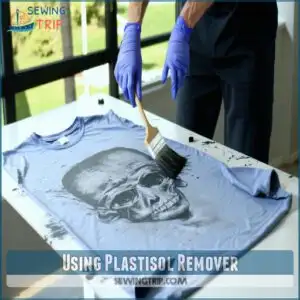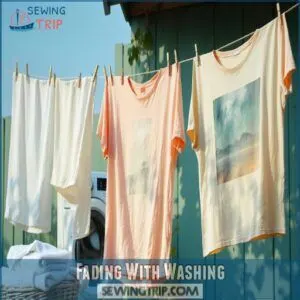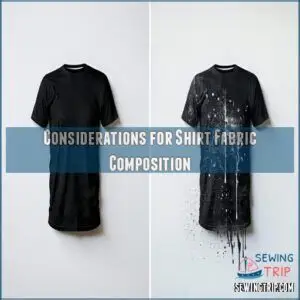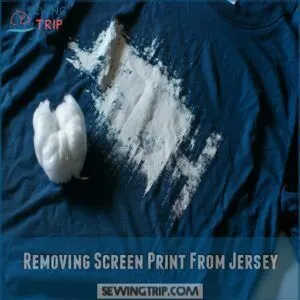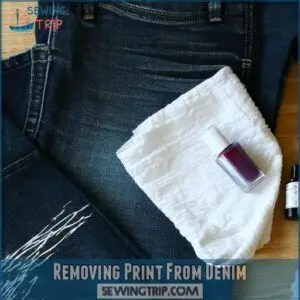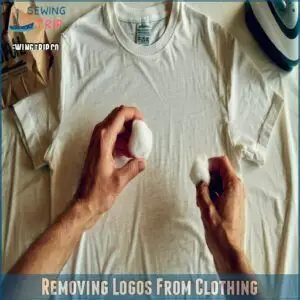This site is supported by our readers. We may earn a commission, at no cost to you, if you purchase through links.
 If you’re wondering how to remove screen printing from a shirt, start with acetone or nail polish remover.
If you’re wondering how to remove screen printing from a shirt, start with acetone or nail polish remover.
Dab it on with a cotton ball and rub gently—test a hidden spot first to avoid damaging the fabric.
For a low-heat fix, place parchment paper over the design, press it with an iron, and peel carefully using a fingernail or scraper.
Plastisol remover works great for tougher prints; just let it soak, scrub, and rinse.
For a hands-off approach, repeated washing in cold water can gradually fade the print.
Keep the fabric in mind—what works for cotton might harm synthetics!
Table Of Contents
- Key Takeaways
- How to Remove Screen Printing From a Shirt?
- Methods to Remove Screen Printing
- Using Acetone or Nail Polish Remover
- Applying Spotting Fluid
- Using Plastisol Remover
- Iron and Peel Technique
- Fading With Washing
- Considerations for Shirt Fabric Composition
- Removing Screen Print From Jersey
- Removing Print From Denim
- Removing Logos From Clothing
- Frequently Asked Questions (FAQs)
- Conclusion
Key Takeaways
- Test any method on a hidden spot first to avoid damaging the delicate fabrics.
- Use acetone or nail polish remover to dissolve the screen printing ink, rubbing gently with a cotton ball.
- For a heat-based removal, place parchment paper over the design and use a low-heat iron to loosen the ink for peeling.
- Fading the design with repeated cold washes is a safe option for delicate fabrics.
How to Remove Screen Printing From a Shirt?

Removing screen printing from a shirt doesn’t have to be complicated.
Start with acetone or nail polish remover—dab a little on a cotton ball and rub it over the print. Make sure to test a small area first to check for damage.
For a gentler option, try spotting fluid or Plastisol remover, both designed for ink. If heat is more your style, cover the print with a cloth, iron it on low heat, and peel the ink away.
Want a simple, slow fix? Patience and multiple washes can gradually fade the design.
Always prioritize fabric safety—harsh chemicals and heat don’t mix well with delicate or synthetic materials. These screen print removal techniques give you flexibility to save that favorite tee!
Methods to Remove Screen Printing
When dealing with screen print removal, you’ve got several tricks up your sleeve.
Chemical solvents, like acetone, can dissolve the ink but might affect certain fabrics—especially synthetics.
If you prefer a hands-on approach, heat transfer techniques (using an iron) can loosen ink, though heat-sensitive materials need extra care.
For a gentler option, regular washing can slowly fade the print.
Each method has its pros and cons, so consider fabric safety before you start.
Picking the right technique makes sure you can remove screen print from a shirt effectively.
Using Acetone or Nail Polish Remover
For quick ink removal, acetone or nail polish remover works wonders.
Before diving in, test them on a hidden spot for fabric safety—some materials don’t play nice. Use a well-ventilated space and wear gloves to safeguard yourself.
Dampen a cotton ball with acetone, then gently rub the print area until the ink starts breaking down. Patience is key—repeat as needed.
Prefer alternatives? Try rubbing alcohol or vinegar for a gentler touch. Always wash the shirt afterward for a clean finish!
When using acetone, consider the acetone remover properties for effective results.
Applying Spotting Fluid
Using spotting fluid is a reliable way to remove screen printing from clothing, but it needs the right approach. Start by understanding the process: spotting fluid is specifically designed for spot removal and works well as an ink dissolver. For delicate fabrics, consider gentle cleaning solutions to avoid damage.
You’ll need a spot removal gun or a soft cloth for precise fluid application. Applying it this way guarantees you target the screen print while protecting surrounding areas of fabric.
Before diving in, prioritize fabric safety. Always test the spotting fluid on a hidden area to verify it doesn’t discolor or weaken the material. If the fabric reacts well, move on to the printed area.
Now, safety’s a must. Work in a well-ventilated space, or even better, outdoors. The fumes can be strong, so wear gloves and a mask for extra protection. Once the print is treated, rinse thoroughly to remove any remaining fluid and chemicals.
Using Plastisol Remover
Got stubborn ink? Plastisol remover is your best friend for tackling plastisol ink on fabrics.
Start by working in a well-ventilated space and wear gloves to protect your skin. For detailed removal instructions, review this screen printing removal guide.
Apply the remover directly to the screen print, letting it soak for 20-30 minutes. Use a soft brush or cloth to gently scrub away the loosened ink.
Rinse with cold water to remove residue and odors. For fabric safety, always test a small area first. This method makes sure effective screen print removal every time, using plastisol remover as the key solution.
Iron and Peel Technique
The iron and peel technique is a tried-and-true heat transfer method for removing screen printing.
It’s simple but requires careful handling to protect your clothing.
Start by placing the shirt on a flat, heat-safe surface.
Put a paper bag (shiny side down) or parchment paper directly over the print.
Set your iron to low heat—skip the steam feature to avoid moisture interfering with the process.
For particularly stubborn prints, consider specialized iron screen print removal products.
Gently press and move the iron over the covered design without lingering too long.
Heat softens the ink, allowing it to transfer to the paper.
When the ink starts peeling, use your fingernail or a soft scraper to lift it off.
Fabric safety is key—test a small hidden area first to avoid burns or damage, especially with synthetics like polyester.
Repeat the process as needed to fully remove the screen printing!
Fading With Washing
Fading screen printing from clothing through washing works best for delicate fabrics.
Stick with cold water or a gentle cycle to avoid setting the ink further. Use a mild detergent to protect the fibers, and skip the fabric softener—it creates a coating that slows down fading.
Try these steps:
- Cold Water Washing: Opt for cold or warm water to loosen the print without damaging the fabric.
- Repeated Washing: Regular washes will naturally fade the design.
- No Fabric Softeners: They hinder the process!
Remove print from shirts gradually, without stressing the material.
Considerations for Shirt Fabric Composition
When removing screen printing, the fabric type matters more than you might think.
Some methods work great on cotton but might ruin synthetics, so always check your shirt’s material first.
Fabric Composition
When removing prints, knowing your fabric’s personality is key.
Cotton and other natural fabrics are forgiving, making them easier to clean up.
Polyester or nylon? That’s trickier—they’re synthetic blends that don’t always play nice with solvents.
Delicate textiles like silk need gentle care to stay intact.
Keep Material Safety in mind: test solutions beforehand and use small amounts.
Not all fabrics agree with your Textile Science experiments!
Material-Specific Methods
Screen print removal methods depend on your shirt’s fabric.
Cotton removal is straightforward with acetone or nail polish remover, but always test a hidden spot first for fabric safety.
Synthetic care requires gentle handling—avoid harsh chemicals and high heat on polyester.
For denim methods, a cold wash and a hot dryer cycle can fade prints effectively.
Material-specific methods like WD-40 can work wonders on nylon.
To remove plastisol ink, use specialized solvents, ensuring fabric compatibility through small patch testing before starting.
Several screen printing removal methods utilize common household items, making the process more accessible and cost-effective with the right techniques.
Synthetic Fabric Care
Synthetic fabrics need extra care during screen print removal.
They don’t handle heat well, so skip the iron or high temps. Harsh chemicals can discolor or damage the material too.
Instead, stick to safe, gentle removal options:
- Test fabric safety first on a hidden spot.
- Use dish soap and a soft brush.
- Avoid abrasive screen print removal methods.
- Opt for low-risk chemical limits.
Removing Screen Print From Jersey
When dealing with jersey removal, it’s all about being gentle.
Jersey fabric, often a soft and stretchy blend, requires careful handling to avoid damage.
Start by flipping the shirt inside out to protect the outer design.
Use a cotton ball soaked in nail polish remover (acetone-based) and lightly dab the back of the print.
This helps soften the ink without harming the material.
After the ink loosens, gently scrape the area with a soft cloth, always moving outward to prevent smudging.
Avoid using heat, as it can set the ink permanently.
If the ink doesn’t budge, try a plastisol remover, which is stronger and targets screen-printed logos effectively.
Always test these products on a small, inconspicuous area first to guarantee fabric safety.
Patience is key; focus on print fading gradually over time instead of rushing.
Removing Print From Denim
Tackling screen printing on denim is easier because this tough fabric holds up to stronger methods. Start with a cold shock treatment. Toss your denim into a cold wash, then quickly switch to a hot dryer. The sudden temperature change can weaken the print’s grip on the fabric.
If that’s not enough, try nail polish remover or acetone. Since denim’s sturdy, you can rub the print more firmly. Dab the solvent onto a cloth and press it against the print, working outward. Just don’t forget about fabric safety—test an inside seam first.
For stubborn designs, mix a sugar paste—just sugar and water. Rub it over the design to wear it down gently.
- Patience wins: prints are resilient.
- Ventilation matters: chemicals can be harsh.
- Avoid over-scrubbing: protect fabric quality.
- Persistence helps fade designs gradually.
Removing Logos From Clothing
Start by evaluating the logo’s size, color, and material to figure out the best removal method. Keep your fabric safety in mind since some materials are more sensitive.
Here’s a simple process to try:
- Choose a method: Nail polish remover (acetone-based) or the iron-and-peel technique works well.
- Prep the garment: Test your method on a small, hidden area to avoid damage.
- Apply carefully: Use acetone with a cotton ball to dissolve the ink, rubbing gently. Peel off loosened bits.
For stubborn logos, try heat transfer with an iron and paper bag to lift the ink. Always rinse and wash to finish the garment restoration. If you’re unsure, consider professional help to keep your clothing intact. Patience is key when you’re learning how to remove screen print safely!
Frequently Asked Questions (FAQs)
How to remove screen printed ink from clothes?
Think of screen-printed ink as stubborn gum on your shoe.
Grab acetone or rubbing alcohol, test a hidden spot, and gently rub with a cotton ball.
Wash afterward, and repeat if needed for perfection.
How to remove screen printing from a t-shirt?
Start by testing acetone or nail polish remover on a hidden spot.
Gently rub the screen print with a soaked cotton ball.
For stubborn ink, try low-heat ironing with a paper bag.
Wash afterward.
How do you remove screen printing?
Removing screen printing is like peeling back layers of a story.
Use acetone or nail polish remover, dab gently with a cotton ball, and scrub softly.
Always test a hidden spot first—your fabric’s safety matters!
How to remove printing from clothing?
Try acetone (like nail polish remover) or rubbing alcohol.
Dab a hidden area first, then rub the print gently.
For heat methods, use a low-heat iron with a paper bag.
Test carefully!
Can you remove screen printing from a shirt?
You can remove screen printing by using acetone, nail polish remover, or rubbing alcohol.
Dab it on the design, let it sit, and gently scrub.
Always test on a hidden spot to avoid damage.
How to remove printing on a T-shirt?
Acetone works wonders for removing T-shirt prints.
Dab it with a cotton ball, test on a hidden spot first, gently rub the design, and rinse.
Always work in a ventilated area, wearing gloves.
How do I remove a logo from a shirt?
Logos cling like stubborn barnacles, but a little patience helps.
Dab a small area with acetone, let it sit, then scrub gently.
Wash after removal to clear residue.
Always test fabric compatibility first!
How do you remove heat press print from a shirt?
To remove heat press prints, apply acetone or nail polish remover using a cloth on the design.
Gently rub until the print softens, then scrape it off carefully.
Wash the shirt afterward to remove residue.
Can you remove a screen print from a shirt?
Did you know around 85% of screen-printed shirts can be fixed at home?
Use acetone or rubbing alcohol, test a small spot first, then dab and gently rub.
Wash afterward to remove residue completely, this is a complete step to ensure the fix is lasting.
How to remove screen printing designs from clothes?
Getting rid of screen printing on clothes? Try acetone or nail polish remover for cotton; carefully rub with a cloth.
For heat-friendly fabrics, use a low-heat iron and paper bag method.
Always test first!
Conclusion
Struggling with how to remove screen printing from a shirt? Don’t worry, there’s a method for you.
Acetone works fast, but test it first. Plastisol remover is perfect for stubborn prints, while ironing and peeling can save the day for lighter designs.
Even simple washing can fade prints over time. The trick is knowing your fabric—cotton and synthetics need different care.
With patience and the right approach, your shirt can look fresh again. Happy refining!
- https://www.professionalgraph.com/seven-proven-ways-to-remove-screen-printing/
- https://www.reddit.com/r/GothFashion/comments/18muohy/removing_print_from_t_shirt/
- https://lambca.com/how-to-remove-printing-from-a-shirt/
- https://americanstitchlv.com/remove-screen-printing-from-a-shirt/
- https://merchize.com/how-to-remove-print-from-shirt/



